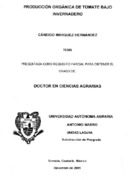Mostrar el registro sencillo del ítem
Producción orgánica de tomate bajo invernadero
| dc.contributor.advisor | Cano Ríos, Pedro | |
| dc.contributor.author | Márquez Hernández, Cándido | |
| dc.contributor.other | Favela Chávez, Esteban | |
| dc.contributor.other | Figueroa Viramontes, Uriel | |
| dc.contributor.other | Nava Camberos, Urbano | |
| dc.contributor.other | Espinoza Arellano, José de Jesús | |
| dc.date.accessioned | 2018-01-19T17:45:27Z | |
| dc.date.available | 2018-01-19T17:45:27Z | |
| dc.date.issued | 2005-12-01 | es_MX |
| dc.identifier.uri | http://repositorio.uaaan.mx/xmlui/handle/123456789/42666 | |
| dc.description.abstract | "La producción orgánica de alimentos es una alternativa para los consumidores que prefieren alimentos libres de pesticidas y fertilizantes sintéticos, inocuos y con un alto valor nutricional. No obstante, la certificación orgánica indica un periodo de transición de tres a cinco años sin aplicación de ningún producto sintético al suelo, periodo que la mayoría de los productores, no están dispuestos a aceptar, porque implica arriesgar su capital. Por otro lado, el tomate cherry y bola orgánico en México alcanza un precio de 3.31 y 5.84 veces mayor que el convencional, respectivamente; producirlo en invernadero, aumentaría los rendimientos y por ende el beneficio económico para el productor. Sin embargo, es necesario un sustrato, que además de sostén, aporte cantidades considerables de elementos nutritivos que satisfagan las demandas del cultivo. Una alternativa, es la composta, que al mezclarla con medios inertes, mejora sus características físicas y químicas evitando la hipoxia. El experimento se llevó a cabo en Matamoros, Coah. México, en las instalaciones del Campo Experimental La Laguna del INIFAP. En el primer experimento, el objetivo fue evaluar tomate cherry y bola en mezclas de diferentes compostas a distintos niveles en combinación con arena y perlita bajo condiciones de invernadero. En tomate cherry, las cuatro mezclas sobresalientes fueron vermicomposta al 50% mas arena así como con perlita al 25, 37 y 50% con una media de 48.507 t ha-1; es decir, 15.88 veces mas, a lo obtenido en producciones de tomate cherry orgánico en campo, sin afectar la calidad de los frutos. En tomate bola, las cuatro mezclas sobresalientes fueron vermicomposta al 50% mas arena así como con perlita al 37 y 50% y biocomposta al 37.5% mas perlita con una media de 91.42 t ha-1; es decir, 9.14 veces mas, a lo obtenido en producciones de tomate bola orgánico en campo. sin afectar la calidad de los frutos. En el segundo experimento, se añadieron fertilizantes orgánicos certificados. Se obtuvo un rendimiento promedio de 130.46 t ha-1; es decir, 13.04 veces mas, a lo obtenido en producciones de tomate bola orgánico en campo, sin afectar la calidad de los frutos" | es_MX |
| dc.format | ||
| dc.language | Español | es_MX |
| dc.publisher | Universidad Autónoma Agraria Antonio Narro | |
| dc.rights | Acceso Abierto | |
| dc.rights.uri | CC BY-NC-ND - Atribución-NoComercial-SinDerivadas | |
| dc.subject | CIENCIAS AGROPECUARIAS Y BIOTECNOLOGÍA | |
| dc.subject.other | Agricultura orgánica | |
| dc.subject.other | Tomate, | |
| dc.subject.other | Sustratos | |
| dc.title | Producción orgánica de tomate bajo invernadero | es_MX |
| dc.type | Tesis de doctorado | es_MX |
| dc.description.abstractEn | "Organic food production is an alternative for consumers who prefer food free of synthetic pesticides and fertilizers, innocuous and with a hígh nutritional value. However, organic certification indicates a period of transition of three to five years without application of any synthetic product to the soil, period that the most of the producers, are not willing to accept, because that implies a risk for their capital. On the other hand, the organic tomato cherry and beef in Mexico reaches a price of 3,31 and 5.84 times greater than the conventional one, respectly; to produce it in greenhouse, would increase considerably to the yields and therefore the economic benefit for the producer. Nevertheless, a support substrate is necessary, that in addition, contributes considerable amounts of nutrients that satisfy the demands of the cultures. An alternative, is compost, that it will have to be mixed with inert materials, to improve the physical and chemical characteristics of the substrate and to avoid the hypoxia. The experiment was carried out in Matamoros, Coahuila, México, in the Experiment Station La Laguna facilities. The first experiment, the objective of this work was to evaluate, cherry and beef tomato in mixtures of different composts with different levels in combination with sand and perlita under greenhouse conditions. In cherry tomato, the best four mixtures were vermicompost with sand at 50% leve! and vermicompost with perlita at 25, 37,5 and 50% levels with a mean yield of 48.507 t ha-1 surpassing the open field yields by 15.88 times, without affecting the fruit quality. In beef tomato, the best four mixtures were vermicompost with sand at 50% level and vermicompost with perlita at 37,5 and 50% levels and biocomposta with perlite at 37.5% leve! with a mean yield of 91.42 t ha"1 surpassing the open field yields by 9.14 times, without affecting the fruit quality. In the second experiment, certified organic fertilizers were added. An average in yield of 130,46 t ha-1 surpassing the open field yields by 13.04 times, without affecting the fruit quality" | es_MX |
| dc.audience | Estudiantes | |
| dc.audience | Investigadores | |
| dc.publisher.place | Torreón, Coahuila, México | es_MX |
